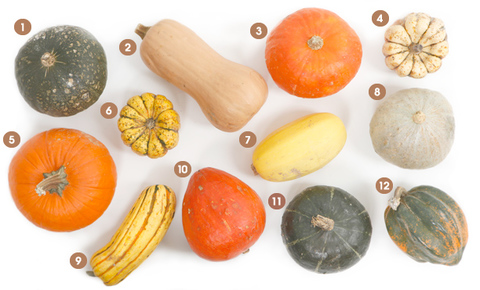
The winter squash family is naturally low in fat and calories, and delivers significant nutritional benefits. For example, one cup of baked butternut squash is rich in vitamins A (from beta carotene), B6, C, and E, as well as magnesium, potassium, and manganese. Butternut Squash has a relatively sweet taste. Kabocha Squash (1, 3) has a nutty, earthy flavor with just a touch of sweetness. Green kabocha is relatively savory, the red kabocha but is much sweeter. Carnival Squash (4) resembles Acorn squash (12) and sweet dumpling squash (6) and has a mellow and sweet yellow flesh. Sugar (pie) pumpkin (5) has a classic pumpkin flavor. Sweet dumpling squash (6) and Delicata Squash (9) both taste like sweet potato. Spaghetti Squash is mild-tasting. Blue Hubbard Squash ha gray-blue skin and sweet-tasting orange flesh. Red Kuri Squash (10) has a chestnut-like flavor. Buttercup squash (11) is very mil in taste. Acorn Squash (12) is mildly flavored and is better eaten green - it can be too tough and fibrous when turned orange. Butternut Squash (2) has a bright orange slightly sweet flesh high in potassium, especially if eaten raw (grated or thinly sliced into salads or coleslaws).
